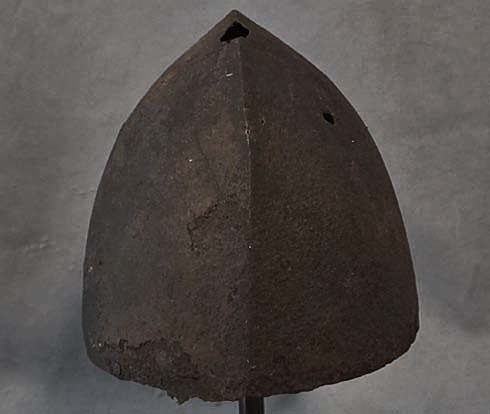
SOLD Rare Antique Medieval 10th -12th century Viking Norman KnightHelmet

E569
SOLD This is an Very Rare, Authentic Antique, Medieval 10th -12th century, European Norman Knight conical Helmet, extremely well hand forged entirely of one piece of thick solid steel with a perfectly smooth exterior surface. Most of the helmets of this period were hammered from iron, only the finest ones were made of steel. This particular helmet is made of high-carbon steel, as indicated by the weight, since high-carbon steel is heavier than iron. The steel of the helmet vibrates from gently taping by fingernail, on broken parts, which, in tests are making sound. The way the skull is damaged with sharp cracks is characteristic for steel, since iron is much more malleable than steel, which confirms the steel characteristic of the helmet. On the base edges of the helmet are visible rivets to attach the hanging cheek and neck pieces.
The Norman helmets were made in three types: (1) Helmets forged entirely of one piece of steel with integral nasal. (2) Helmets forged entirely of one piece of steel without nasal. (3) Helmets constructed from several plates riveted together. Sometimes the nasal was made separately and riveted to the helmet.
This helmet is almost identical in shape to the Norman helmet, so-called “helmet of St Wenceslas,” which had been also forged from one piece of steel without the nasal. The nasal guard of the St Wenceslas helmet, decorated with the figure of Jesus, is not original to the helmet and had been added 200 years later to that helmet. Also, the skull of the helmet, in the collection of Kunsthistorisches Museum in Vienna, Austria and the helmet in the British Museum is very similar in form to our helmet, except it has the nasal.
Further, more famous, The Lewis chessmen, made circa 1150-1200, showing the Normans knights, wear the helmets with out a nasal like this helmet.
Please see the links below:
http://www.flickr.com/photos/45665351@N00/4023338694/in/photostream
http://commons.wikimedia.org/wiki/File:KHM_Wien_A_41_-_Moravian_nasal_helmet,_11th_century.jpg
https://commons.wikimedia.org/wiki/File:St_Wenceslas_helmet.jpg
http://en.chessbase.com/home/TabId/211/PostId/4006665
http://www.gav.org.uk/Research/Viking%20Age%20Helmets.pdf
Scandinavian Normans penetrated entire medieval Europe on the eastern territory of northern and southern Russia where they created a Norman’s Kievan Rus state, and in the west to Ireland Brittan, northern France, and Sicily. Their superior armor and swords were known in many countries as the best quality military equipment in this period of time, not only in European states, but also, in eastern countries, including the Jewish Khazar Empire and Islamic Caliphate. According to the Muslim authors from the early Middle Ages, the Norseman swords and helmets were highly valued in the Islamic World. The participation of the Normans in large numbers in the crusades, made their helmets commonly used, not only by the Christian crusaders in Holy Land, but also by the Muslim warriors. There are only a few of these authentic Norman helmets which survived to the present day, and most of them are in famous museum collections. This particular specimen is an extremely rare object and has been placed for sale, for the first time.
REFERENCES: The most important source on this subject is early medieval iconography, which has been published in one of the best books of this subject, “Arms and Armour of the Crusading Era 1050-1350: Western Europe and the Crusader States (v. 1) “by David Nicolle.
This is the best reference existing on our helmets that show similar Norman conical helmets without the nasal that are presented on the following pages:
364,365,366,368,372,451,464,484,505,532.
The buyer will be provided with photocopies of the pages from this reference.
CONDITION: Corroded, damaged, dents, several cracks. Damage most likely made by the impact of a sword or mace. Some rust holes, however the core is very strong and stable.
DIMENSIONS: The overall length: 24cm (9 3/8 in). Width: 19.5 cm (7 5/8 in). Height: 18.5 cm (7 1/4 in).
Weight: 1214 grams = 1.214 Kilograms (2.68 pounds).
Such a Rare specimen, hardly ever appears for sale, and is the only one available for sale worldwide, and can be a great addition for a world class museum, or the private collection.

